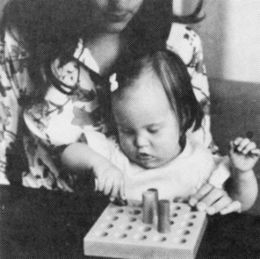Hesperian Health Guides
Down Syndrome
These are some typical signs of Down syndrome (not all children have all these signs):

- at birth, baby seems floppy and weak.baby does not cry much.

- the baby takes longer than other babies her age to: turn over, grasp things, sit up, talk, walk.
- when suddenly lowered, the baby does not react by spreading her arms, as most other babies do.
- eyes slant upward; sometimes cross-eyed or poor sight
- ears low
- small mouth, hangs open; roof of mouth is high and narrow; tongue hangs out

- a fold of skin covers the inner corner of the eyelid.
- eyelids may be swollen and red.
- the iris of the eye has many little white specks, like sand. These usually go away by 12 months of age.
 |
|
|
 |
|
 |
| |
|
|
Other possible signs:
- Elbow, hip, and ankle joints may be very loose and flexible.
- One out of 3 has heart problems.
- May develop leukemia (blood cancer).
- Check older children for hearing and vision loss.
- One out of 10 has neck bones which can slip and pinch the nerve cord in the spine. This may cause sudden or slowly increasing paralysis or sudden death.
Contents
Care of children with Down syndrome and other forms of cognitive delay
Cognitive delay in children with Down syndrome can be mild, moderate, or severe. Some children never learn to speak. Others talk (and often love to talk). Many can learn to read and write. Most of these children are very friendly and affectionate, and behave well with people who treat them well. Even those who have more severe cognitive delay, with help and good teaching usually learn to take care of their basic needs, and to help out with simple work. They can live well with their families and communities.
 |
| In one village, a young man with Down syndrome works hauling water from the river, a job he is happy and proud to do. |
In rural areas particularly, they can learn to do many important jobs. Sometimes they do repetitive jobs as well or better than other people.
But their physical and mental development takes longer than other children’s. So parents and all those who take care of these children must be very patient with them and from a very early age do all they can to help them develop their mental and physical capabilities. To avoid or solve behavior problems, parents need to be very consistent in how they treat their children and in what they expect of them. The child needs a lot of praise and encouragement for things he does well (see Chapter 40).
Some children with Down syndrome can go to school, but they will need extra help. It is important that teachers understand their disability and help other children to treat the child with respect. Unless the child is given understanding and extra help at school, in rural areas it may sometimes be better for the child with Down syndrome to be educated at home through helping his family around the house and in the fields.
 |
| A child with Down syndrome learns to remove pegs from a pegboard. Later she will learn to place the pegs. Photo from Teaching Your Down’s Syndrome Infant by Marci J. Hanson. |
There are 3 main concerns in caring for a child with Down syndrome:
- Help the child to develop her or his mental and physical abilities.
- Protect the child from infectious diseases.
- Prevent or correct deformities.
Here we will discuss the last 2 concerns. The first we will cover in other chapters.
Protection from infections

Children with Down syndrome get sick more often than other children. They can easily catch colds, bronchitis, pneumonia, and other infections. So it is very important to protect their health.
- Breastfeed the child as long as possible. Breast milk has ‘antibodies’ that help the child to fight infections. (If he cannot nurse well, milk your breasts and feed him the milk, using a spoon or any way that works.)
- Like any baby, at 6 months start giving her other foods such as fruit, beans, eggs, and rice, but also continue to breastfeed her. (Like any baby, weigh her each month at the health center to be sure she is growing well.)
- Vaccinations can protect her from many childhood diseases. A child with Down syndrome who catches measles or whooping cough can easily get pneumonia.
- Early medical attention When she gets a sore throat, earache, or bad cough, take her to a health worker as soon as possible.
PREVENTION of foot deformities and other conditions
- Check all newborns for possible dislocated hip, so that it can be corrected as soon as possible.
|
do not use hard shoes that bend the big toe inward like this. | It is better to wear tennis shoes, or other soft shoes, or sandals. | |
 |
This can cause a painful dislocation here. |  | |
When the big toe sticks out a lot, its position can sometimes be corrected with surgery, so that shoes will fit more comfortably.
- If the child has severe flat feet, a special insole may help.
- If any sign of paralysis or lack of feeling develops in the hands, feet, or body, get advice from an orthopedist or a neurosurgeon.
PREVENTION of Down syndrome
One out of every 700 children is born with Down syndrome. Down syndrome is more likely to occur in babies of parents older than 35 years of age. Individuals or families may want to plan to have no more children after age 35 (see Where There Is No Doctor, Chapter 20). Also, if a couple already has one child with Down syndrome, the chance of having another is increased (about one in 50).
In some countries a test (amniocentesis) can be done at about 4 months of pregnancy to see if the child will have Down syndrome. If so, the family can consider abortion.


